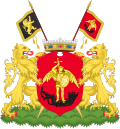
The Volksraad of the South African Republic was the parliament of the former South African Republic (ZAR), it existed from 1840 to 1877, and from 1881 to 1902 in part of what is now South Africa. The body ceased to exist after the British Empire's victory in the Second Anglo-Boer War. The Volksraad sat in session in Ou Raadsaal in Church Square, Pretoria.
De Grootste Nederlander was a public poll held in 2004 by the broadcasting company KRO of the Publieke Omroep. The series has the BBC's 100 Greatest Britons TV format. During the series, it included individual programmes on the top ten, with viewers having further opportunities to vote after each programme.

The Tuyll family is a Dutch noble family, with familial and historical links to England, whose full name is Van Tuyll van Serooskerken. Several knights, members of various courts, literary figures, generals, ambassadors, statesmen and explorers carried the family name.
The Slachter's Nek Rebellion was an uprising by Boers in 1815 on the eastern border of the Cape Colony.

Kunst zij ons doel, or KZOD, is the name of an artists club in the Waag, Haarlem.

The Great Theatre of Dutch Painters and Paintresses, or De groote schouburgh der Nederlantsche konstschilders en schilderessen, as it was originally known in Dutch, is a series of artist biographies with engraved portraits written by the 18th-century painter Arnold Houbraken. It was published in three volumes as a sequel to Karel van Mander's own list of biographies known as the Schilder-boeck. The first volume appeared in 1718, and was followed by the second volume in 1719, the year Houbraken died. The third and last volume was published posthumously by Houbraken's wife and children in 1721. This work is considered to be a very important source of information on 17th-century artists of the Netherlands. The Schouburg is listed as one of the thousand most important works in the Canon of Dutch Literature from the Middle Ages to the present day.
The Dutch Prix de Rome is based on the originally French Prix de Rome and is awarded annually to architects and artists younger than 35. The award was initiated in 1807 by Louis Bonaparte, then ruler of the Kingdom of Holland, and confirmed after independence by William I of the Netherlands. It was canceled in 1851 by the statesman Johan Rudolph Thorbecke and reinstated in 1870 by William III of the Netherlands. Since then the winners are selected by the Rijksakademie in Amsterdam.

Oud Eik en Duinen is a cemetery in The Hague, the Netherlands, formerly called Eik en Duinen and also nicknamed "the Dutch Père-Lachaise". The cemetery is built around a chapel constructed around 1247 by William II of Holland in honor of his father, Floris IV, Count of Holland. This chapel was partially demolished in 1581, and in the 17th century the area was again used as a cemetery. When Eik en Duinen was full, a new cemetery, Nieuw Eykenduynen, was constructed in 1891 across the road, and since then the old cemetery is known as "Old" Eik en Duinen.

Ten Duinen Abbey or the Abbey of the Dunes was a Cistercian monastery at Koksijde in what is now Belgium. It was one of the richest and most influential religious institutions in the medieval County of Flanders. It later relocated from Koksijde to the city of Bruges.

The Nederlandsche Vereeniging voor Ambachts- en Nijverheidskunst (V.A.N.K.) was founded in 1904. It was founded by Jacob Pieter van den Bosch, Herman Hana, Klaas van Leeuwen, Theo Molkenboer, and Willem Penaat. At the turn of the century the idea of artist-craftsmen was emerging. The existing Dutch societies and clubs for painters and architects did not adequately represent these artisans and they formed V.A.N.K., the first society for designers in the Netherlands.

Onze Kunst van Heden was an exhibition held in the winter of 1939 through 1940 at the Rijksmuseum in Amsterdam. Due to the threat of invasion in the years leading up to World War II, the Netherlands' government stored many items from the Rijksmuseum's permanent collection. The resulting empty gallery space was utilized by contemporary Dutch artists to exhibit and sell their art. It was organized by the director of the Rijksmuseum Frederik Schmidt Degener. The show was open to all artists, with each artist allowed to enter four pieces. 902 artists exhibited 3,200 works of art in 74 rooms and cabinets of the Rijksmuseum.
„De kunstenaar kan in tijden van maatschappelijke benauwenis weinig positiefs doen om rampen af te wenden, maar wel kan hij door mede te helpen nationale uitingen op het eigenaardigst naar voren te brengen het gemeenschapsbesef versterken. Wanneer de belangstelling van het publiek uitgaat naar deze manifestatie, die in zulk een omvang in Holland nog niet gezien is, dan zal menige kunstenaar zich op zijn beurt gesterkt voelen".
"The artist can do little positive in times of social distress to avert disasters, but he can, by helping to bring out national expressions in the most idiosyncratic way, strengthen the sense of community. When the public is interested in this event, which has not yet been seen to such an extent in Holland, many artists will feel strengthened in turn."
This page is based on this
Wikipedia article Text is available under the
CC BY-SA 4.0 license; additional terms may apply.
Images, videos and audio are available under their respective licenses.


























